As life returns to the gardens this spring, it’s not just the plants that are stirring.
At a turn in our driveway there is a large volcanic rock, no doubt put there by the previous owners, to prevent vehicles from cutting the corner. Typical of lava rock, it’s riddled with various sized holes. This rock seems to be a favored habitat of our resident lizards, and our bees enjoy drinking water that becomes trapped in the holes in winter and spring.
Yesterday, while out in the garden, checking first for bees, I sat on the rock for few minutes during a brief break. As I looked down though I noticed something was moving, just below my knee. No…wait, it’s lots of somethings moving. A mass of recently hatched spiderlings!
We have no shortage of orb weaving spiders here, as becomes apparent during the fall months when almost every tree seems to be draped with spider webs.
Because of the vivid yellow color, and the markings, at first I thought these might be Argiope sp. spiderlings. We found two species here last autumn out in the gardens, Argiope aurantia…
…and a few weeks later, Argiope trifasciata.
After some reading I felt fairly confident ruling out Argiope aurantia spiderlings though. The yellow coloring of these spiderlings might seem convincing, but it turns out that Argiope aurantia spiderlings are typically more white in coloration, not yellow.
Behaviorally something was apparently amiss too. Argiope aurantia spiderlings emerge gradually over a period of days, not in a matter of hours en masse. [1]
That said, Argiope trifasciata spiderlings reportedly do all hatch out together though, and engage in clustering behavior, much like these spiderlings, when they first hatch.
The clusters tend to be tighter in cooler weather.
As the temperature warms though, the cluster becomes more open.
The spiderlings clearly had constructed a communal tangle of web material. Argiope aurantia spiderlings do not typically form tangles of web material, but Argiope trifasciata spiderlings do, so perhaps now I had my answer?
Perhaps not. I finally convinced myself that these spiderlings likely belong to neither Argiope species!
Argiope sp. spiders generally construct their webs, and position their egg sacs, amidst vegetation. We watched the females build, and rebuild their webs repeatedly last year.
The egg sac producing these spiderlings wasn’t located in vegetation though, but was clearly embedded deep within one of the holes in the lava rock, along with what looks like the remains of someone’s meal.
Honestly, I couldn’t even envision an Argiope spider actually fitting inside this hole, as they are substiantially sized arachnids.
An Argiope egg sac is typcially smooth on the outside surface, and somewhat papery. The exterior of this egg sac, however, seemed very fluffy in comparison.
After a little further sleuthing, it appears these spiderlings may in fact be the offspring of the European Garden Spider (Araneus diadematus), that is known to frequent this area.
The appearance of the egg sac, with it’s more cottony appearing exterior, the egg sac location, and the color and pattern of the spiderlings all seem to fit much better with Araneus sp., than Argiope sp. It’s difficult to know for certain though, as the female responsible for producing the egg sac would not have survived the winter.
Next time I’ll have to pay closer attention during the fall months to see if I can find any Araneus species spiders associated with their egg sacs, and watch closely for the spiderlings the following spring.
———————-
[1] Tolbert, W. W. 1977. Aerial Dispersal Behavior of Two Orb Weaving Spiders. Psyche 84:12-27

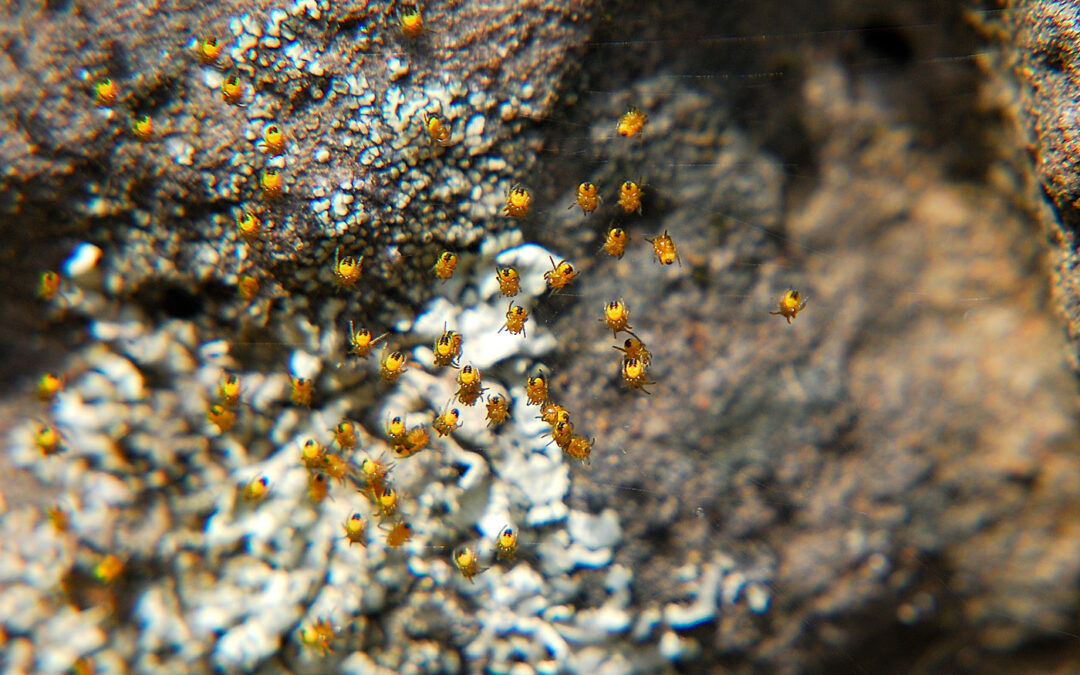
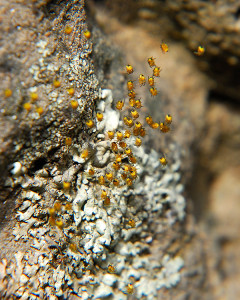
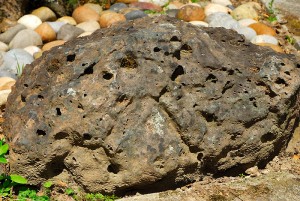
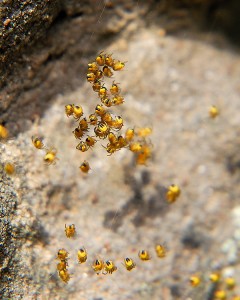
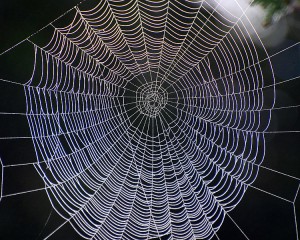
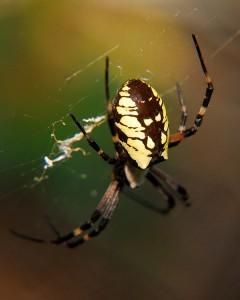
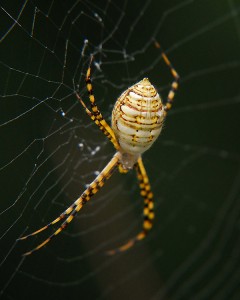
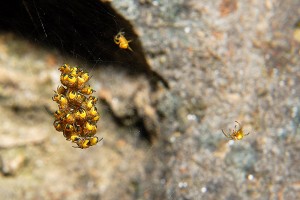
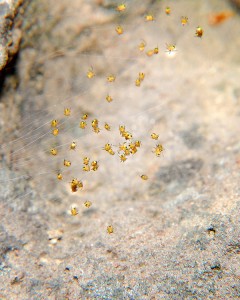
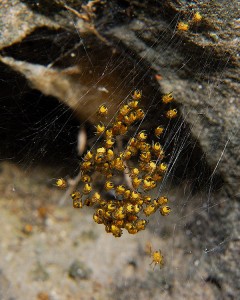


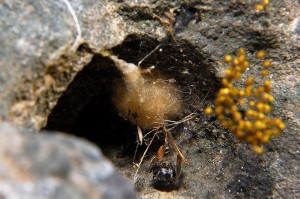
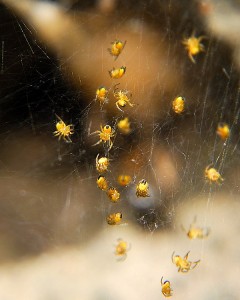








Nice detective work!
Thanks! This was definitely a case of ‘never assume’. If you Google both Argiope and Araneus species spiderlings, you’ll see images that look just like this. The Argiope assumption is a common one, but it seems it’s most likely incorrect. Now I really want to pay attention next fall!
Scary little critters, yet your photographs present beautiful portraits.
Please to meet you, Argiope aurantia and Argiope trifasciata… your markings could be turned into gorgeous fabric pattern…
Fashionista!
Those Argiopes are gorgeous, aren’t they? The A. trifasciata was a surprise last year. We found her web strung between two Salvia ‘Winifred Gilman’ plants. I knew we had the A. aurantia species, but hadn’t seen her before.
That is very cool, and I like that you took the time to try to sleuth it out. I read about spiderlings (orb weavers, I think) hatching and then dispersing on strands of silk in the breeze, which makes me happy whenever I remember it. Long live your little flecks of gold! I think they’re kinda cute.
I read that too. There are a number of species that seem to depend on the wind for dispersal. Their silk strands acting like little parachutes. Nature never ceases to amaze me. I hope I see many more of these flecks of gold here, they’re truly beautiful.
Hi Clare,
Lovely photos; I often see similar here later in the summer but we don’t tend to get Orbs here (not sure if we do at all) and I assume they must be the wolf spiders we have everywhere.
No fan of spiders but I do often find myself getting very close and personal with them and my Macro lens… As long as they’re not in the house or on me then I’m OK… Sort of… 😉
Orbs are ubiquitous worldwide, I expect you have a least a few species there. Anything constructing the ‘classic’ spider web is an orb-weaver. The species are numerous. Our Argiopes here are just one of the largest species on the farm, except for the rare sighting of a tarantula (and I honestly don’t know if they build webs). They are a little creepy, but also amazingly fascinating creatures. Like bees, the females are able to provision for their young so they can survive winter without a ‘parent’.
What a cool find…I bet you are glad you took your break when you did! I think garden spiders are awesome. Do these spiders hang around so you can see them as they grow and perhaps help id them? Great sleuth work on your part!
I’m honestly grateful I didn’t squish the poor little spiderlings. Years ago, I used to be a spider-squasher. Until I realized my irrational fear of spiders…let’s face it, I’m a hundred and mumble-mumble pounds, compared to their mere fraction of a gram, it just didn’t make sense. As a gardener, I’m THRILLED to see these spiderlings. I know they won’t all make it, but the fact I didn’t actually sit on them, should at least give them a fighting chance 😛
Clare, from bees to spiders wow…I always learn so much and am excited to continue to learn more in my garden….
Bees, and spiders, as gardeners, we need them all!
Clare,
Agreed no any type of Argiope. They look like our Marbled Orbweavers, but I doubt they are found our west.
I just hope they survived all the rain we just had!
Great job of nature observation and detection. Or detectivity? we have golden garden spiders, Argiope aurant-i-whatever. I like to sit on the deck in the late afternoon with a glass of wine and watch them spin their webs. I also like to sit on the deck with a glass of wine when they’re not spinning their webs. I guess it’s the wine that I enjoy more than the spiders. Oh, hey, I see that we’re the same weight. One hundred and mumble mumble pounds. 😉
I’m so glad I didn’t squish these spiders. My one hundred and mumble mumble self wouldn’t have been any match for these tiny things. They’re not much bigger than the head of a pin!
Clare, I love this spider~She’s fantastic and welcome in my garden. You’ve captured her spider babies beautifully. xogail
I used to ‘hate’ spiders, but I’m so glad I got over that. I’m actually very happy to see them in the garden, and who knows how bad our pest problems would be without them. I just don’t know very many of them well enough to recognize their species on sight.
Fascinating! Of course I’m a little more partial to frogs, but it’s still fascinating to hear about those babies – and learning from you how to identify them.
I admit, the frogs do have a greater cuteness factor, but these spiders are no less important in the web of things here. I’m happy to see them both.
You’ve got the markings of a great detective. They are beautiful little things that’s for sure. Thanks for sharing these great shots. We get a type of Orb Weaver spider here too, but it’s enormous! I’ve never seen any spiderlings though.
A number of the orb-weaver spiders are very large. I say I love spiders, now, but the largest here (our drab brown tarantula) is maybe only four inches across? I’d love to see a photo of your species!
Oh how amazing!! I love these close up shots of spiders and bugs – especially the newbies!
Unfortunately, they’re so small they were almost impossible to get a clear shot of. Was so fun seeing these tiny spiders emerge though!
I don’t like spiders but I know they are an important part of the ecosystem. Thank you for the stunning photos.
A lot of people don’t like them, and I used to be one of them, but I suppose the gardener in me came to understand how very important they are. I even rescue the ones found in the bathtub now 😉
One of the things I’ve been surprised about in the last few years is the sheer diversity of spider species we have on our farm. We haven’t seen any of the orb spiders, but we seem to have quite a few that stalk and pounce on their prey. They are really interesting to watch, especially once you realize that you are far too big for them to even think about tasting. On a related note- I read recently that many skin inflammations that are diagnosed as being “spider bites” are actually not spider bites, but small staph infections or other minor dermatitis-type infections. So even less reason to fear spiders!
I’ve been bitten lots of bugs over the years, and around here, especially ticks…ewwww. I don’t think I’ve ever had a spider bite though. I love seeing how many species we find here, although I still can’t identify most of them. They’re all fascinating though, and I love seeing the different types of webs they build too. The orb-weavers especially are remarkable architects.
Great pics! I could’nt see them until I enlarged the pic. Amazing! Not a type of Spider we get in Ireland. I don’t think I’ve seen a yellow Spider.
They even a little difficult to see enlarged. I was surprised how vivid yellow they are. I would expect something that brightly colored to be at risk of being eaten!
My goodness! You’re so thorough! It’s weird that we both spotted babies the same weekend. They certainly were challenging to photograph…
They really are, especially when they’re hanging in that tangle of webbing, it makes it difficult to focus!
Great photos of these tiny little guys. I love when the babies hatch in spring. The slightest breeze on their tiny webs and they all run and huddle together. A pretty neat sight to find them.
I’d never seen a cluster like this before. I did read in the paper linked above that some of the Argiope spiders are wind dispersed. That would be so much fun to see.
Great post! Very interesting, love the pictures and your detective work.
Thanks Barbara!
Great find, Clare. I like how you did your research and how you ruled out one kind over another. Very thorough. Your images are wonderful too.
I was so sure these were Argiope aurantia at first. It was good lesson in the value of doing one’s homework!
Fascinating pics of all the spiderlings! Orb spiders can be so beautifully colored, though rather alarmingly large!
Some of them can be quite startling to bump into the garden. I also find them fascinating to watch as they construct their webs though, as they’re big enough you can really see what they’re doing!
Spiderlings – I never even knew it was a word! In your first photograph the little spiderlings look as if they are in mid air!
You know, maybe I made that up…perhaps spiderling isn’t a word? 😉
Lovely shots Claire – I love the spider webs!
It’s quite impressive here in October, usually a week or two before Hallowe’en. We get so many webs strung in the trees here, and if it’s a misty morning they really stand out! They’re beautiful to see.
Baby spiders—how cute!!! I never thought I would say that.
I don’t think I ever heard someone call baby spiders cute, but actually have to agree with you 🙂
This is a WONDERFUL posting! Thank you for opening the pathways to understanding and love. I adore these spiders and have studied them closely.
All joys to you,
Sharon Lovejoy Writes from Sunflower House and a Little Green Island
Glad you enjoyed them Sharon. I think spiders are very misunderstood by many. They’re actually quite remarkable creatures when you get to know them better.
Hi Clare!
My friend, Sue was telling me you had a fantastic blog. She was right. If you don’t mind, I’ll follow along. I’ll try not say anything too stupid.